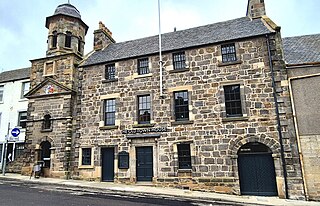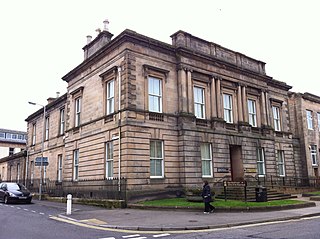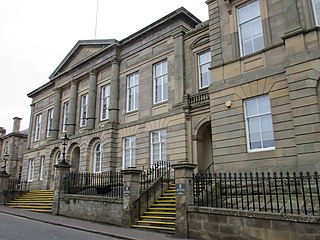
Greenock Sheriff Court is a judicial building on Nelson Street in Greenock in Scotland. The structure, which continues to operate as a courthouse, is a Category B listed building.

Dundee City Chambers is a municipal facility in City Square, Dundee, Scotland. The city chambers, which is headquarters of Dundee City Council, is a Category B listed building.

County Buildings is a municipal structure in the High Street in Kinross, Perth and Kinross, Scotland. The structure, which accommodates the local area offices for Perth and Kinross Council, is a Category B listed building.

The Old Sheriff Court is a former municipal and judicial building in Wilson Street, Glasgow, Scotland. The building, which is home to the Scottish Youth Theatre, is a Category B listed building.

Inverkeithing Town House is a municipal building in the Townhall Street, Inverkeithing, Fife, Scotland. The structure, which is used as a base by members of the local community council, is a Category A listed building.

Invergordon Town Hall is a municipal building in the High Street in Invergordon in the Highland area of Scotland. The structure, which is used as a community events venue, is a Category B listed building.

Banff Sheriff Court is a judicial structure in Low Street, Banff, Aberdeenshire, Scotland. The structure, which was the meeting place of Banffshire County Council and was also used as a courthouse, is a Category B listed building.

Elgin Sheriff Court is a courthouse in the High Street, Elgin, Moray, Scotland. The structure is a Category B listed building.

Paisley Sheriff Court is a municipal structure in St James Street, Paisley, Renfrewshire, Scotland. The complex, which was the headquarters of Renfrewshire County Council and is currently used as a courthouse, is a Category A listed building.

Dumbarton Sheriff Court is a judicial structure in Church Street, Dumbarton, West Dunbartonshire, Scotland. The complex, which was the headquarters of Dunbartonshire County Council and is currently used as a courthouse, is a Category B listed building.

The Justiciary Building is a judicial structure in the Lawnmarket in Edinburgh, Scotland. The structure, which operates in conjunction with similar facilities in Glasgow and Aberdeen, is dedicated for the use of the High Court of Justiciary, which is the supreme criminal court in Scotland. It is a Category B listed building.

Hamilton Sheriff Court is a judicial building in Almada Street, Hamilton, South Lanarkshire, Scotland. The building, which continues to serve as the local courthouse, is a Category A listed building.

Lanark Sheriff Court is a judicial building in Hope Street, Lanark, South Lanarkshire, Scotland. The building, which continues to serve as the local courthouse, is a Category B listed building.

Forfar Sheriff Court is a judicial building in Market Street, Forfar, Angus, Scotland. The building, which remains in use as a courthouse, is a Category B listed building.

The Corn Exchange is a commercial building in the Market Place, Arbroath, Angus, Scotland. The structure, which is now used as a public house, is a Category B listed building.

The Corn Exchange is a commercial building in Court Street, Haddington, East Lothian, Scotland. The structure, which is now used as a community events venue, is a Category B listed building.

Swaffham Town Hall is a judicial building in Whitecross Road in Swaffham, a town in Norfolk, in England. The building, which is now in residential use, is a Grade II listed building.

County Buildings was a judicial building on Bank Street in Airdrie in Scotland. The building, which was the venue for hearings of the Airdrie Sheriff Court, was demolished in 1969.

The Guildhall, also known as The Guildhall & Linen Hall, is a historic building on the High Street in Dunfermline in Scotland. The structure, which currently operates as a public house, is a Category A listed building.

The Old Sheriff Court is a judicial building on St Marnock Street in Kilmarnock in Scotland. The building, which currently accommodates the procurator fiscal's office, is a Category B listed building.





















